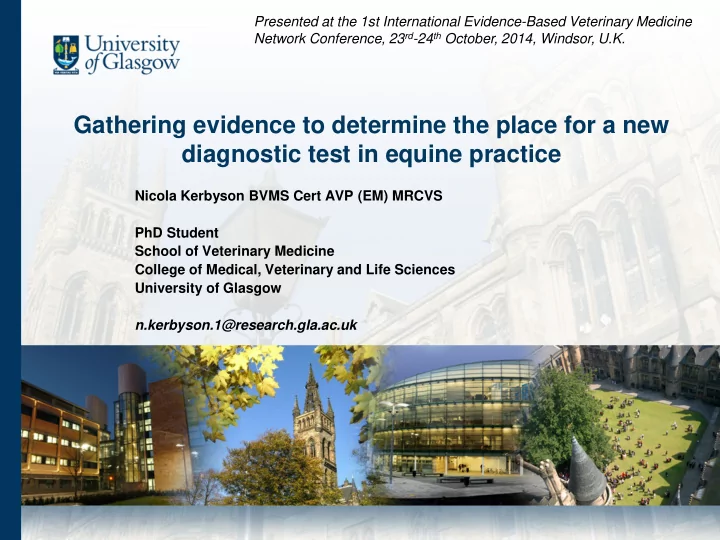

Presented at the 1st International Evidence-Based Veterinary Medicine Network Conference, 23 rd -24 th October, 2014, Windsor, U.K. Gathering evidence to determine the place for a new diagnostic test in equine practice Nicola Kerbyson BVMS Cert AVP (EM) MRCVS PhD Student School of Veterinary Medicine College of Medical, Veterinary and Life Sciences University of Glasgow n.kerbyson.1@research.gla.ac.uk
Declarations Conflict of interest declaration PhD funded by Freedom Health LLC who manufacture the test I am discussing. Acknowledgements Dr Tim Parkin Professor Derek Knottenbelt GN Hall and Freda Hall Bursary Scheme
Lateral flow immunoassay
Lateral flow immunoassay • Qualitative or semi-quantitative • Strip of carrier material containing dry reagents which are activated upon application of a fluid sample
Succeed faecal blood test (FBT) • Commercially available lateral flow immunoassay • Marketed to ‘aid diagnosis of GI tract conditions’ • ‘Helps differentiate foregut and hindgut conditions’ • Detects both albumin & haemoglobin in faeces • Positive faecal albumin is diagnostic of ‘colonic ulceration’
‘Colonic ulceration’ • Poorly defined condition • May represent the end stage of numerous diseases including: – parasitic gastroenteritis – inflammatory bowel disease – right dorsal colitis • Prevalence of 63% of 545 horses ( Pellegrini 2005) • Lesions not defined by histopathology – gross appearance only Fig courtesy of F Pellegrini Pellegrini, F.L., 2005. Results of a large-scale necroscopic study of equine colonic ulcers. J. Equine Vet. Sci. 25, 113–117. doi:10.1016/j.jevs.2005.02.008
Validation • Best to compare to ‘gold standard’ diagnostic test • Problems: 1. Disease poorly defined- likely multiple disease states could result in a positive test • Parasitism • IBD • Colitis 2. Potential for false positives • Rectal collection of sample 3. Intestinal disease is difficult to diagnose in horses • No gold standard ante-mortem marker of intestinal disease
Initial approach to validation Clinically healthy vs. hospital cases Test Hospital Healthy TOTAL Result Alb + 110 23 133 53 23 76 Alb - 163 46 209 Sensitivity= 23/46 50% Does this represent Specificity= 53/163 32% subclinical disease or false positives? Positive predictive value= 23/133 17% Negative predictive value= 53/76 70%
Colic cases TEST Colic signs in last 24hrs No colic TOTAL RESULT Alb + 20 113 133 Alb - 4 72 76 24 185 209 Sensitivity= 20/24 83% Specificity= 72/185 39% Positive predictive value= 20/133 15% Negative predictive value= 72/76 95%
Faecal haemoglobin following epistaxis TEST RESULT Epistaxis No epistaxis TOTAL Hb + 5 96 101 Hb – 0 109 109 5 205 210 Sensitivity: 5/5 100% Specificity: 109/205 53% Positive predictive value=5/101 5% Negative predictive value=109/109 100%
High sensitivity / low specificity Common scenario in veterinary medicine to have an indicator of disease with a high sensitivity and low specificity: • Pyrexia • Tachycardia • Anaemia High negative predictive values mean that this test has the potential to be used as a screening test…. Next question: Does a positive faecal haemoglobin or albumin reflect intestinal disease or could it be a ‘normal’ finding?
Post mortem study • Detailed examination of the entire intestinal mucosal surface in horses euthanised for non GI related reasons • Faecal haemoglobin and albumin status determined prior to euthanasia • Post mortem performed within 30minutes of death to minimise post mortem change Time consuming and messy!
Intestinal lesions
Evaluation of faecal albumin as a marker of colonic pathology Colonic mucosal pathology detected in 13/14 horses euthanised for reasons other than GI disease Colonic Normal colon pathology Albumin + 11 1 Albumin - 2 0 The prevalence of colonic pathology has Sensitivity= 11/13= 85% previously been Specificity= 0/1= 0% grossly underestimated PPV=11/12= 92% NPV=0/2= 0% We need to find more normal horses!
Evaluation of faecal haemoglobin as a marker of colonic pathology Colonic pathology Normal colon Haemoglobin + 8 5 Haemoglobin - 0 1 Sensitivity= 8/8 100% Haemoglobin negative is rare Specificity= 1/6 17% difficult to draw conclusions at PPV=8/13 62% this stage. NPV=1/1 100%
Intended use of test • Manufacturers design this test to be interpreted in combination i.e. the combination of Hb and Alb + and – should indicate the location of the pathology. • Not enough data to validate this yet.
Conclusions • Colonic mucosal pathology has previously been grossly underestimated • Initial analysis suggests a positive faecal albumin has a high PPV for colonic pathology • Defining the spectrum of observed pathology is currently being undertaken- with view to being able to determine the likely clinical significance of these lesions
Recommend
More recommend